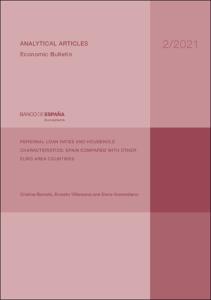Registro completo de metadatos
| Campo DC | Valor |
|---|---|
| dc.contributor.author | Barceló, Cristina |
| dc.contributor.author | Villanueva, Ernesto |
| dc.contributor.author | Vozmediano, Elena |
| dc.coverage.spatial | España |
| dc.coverage.spatial | Zona euro |
| dc.date.accessioned | 2021-03-26T19:43:09Z |
| dc.date.available | 2021-03-26T19:43:09Z |
| dc.date.issued | 2021-03-25 |
| dc.identifier.uri | https://repositorio.bde.es/handle/123456789/15712 |
| dc.description | Artículo de revista |
| dc.description.abstract | Interest rates on new lending to households for purposes other than house purchase are generally higher in Spain than in other euro area countries. This may be because borrowers have different characteristics, or because Spanish households pay higher interest rates than similar households in other countries, owing to regulatory aspects, different competition levels or other factors. Data from the Eurosystem’s Household Finance and Consumption Survey, which compiles data on household wealth, debts and income in each euro area country, show that borrowers in Spain have fewer assets and are more likely to be unemployed than those in the other countries analysed. However, these differences between borrowers explain only a small part of the difference between Spanish personal loan rates and those applied in the other euro area countries. In consequence, most of the difference is due to the different way in which Spanish financial institutions assess household characteristics. One possible explanation for the higher interest rates in Spain is that, even when comparing employed persons with similar characteristics, Spanish households have a higher risk of job loss than German and French households and, for the same income level, greater income instability than German households. The survey data also show that Spanish indebted households that pay higher interest rates are also more likely subsequently to fall behind in their debt payments and to experience income declines. In Spain, therefore, high interest rates reflect this greater future income instability. |
| dc.format.extent | 10 p. |
| dc.language.iso | en |
| dc.publisher | Banco de España |
| dc.relation.ispartof | Economic Bulletin / Banco de España, 2/2021 |
| dc.rights | Reconocimiento-NoComercial-CompartirIgual 4.0 Internacional (CC BY-NC-SA 4.0) |
| dc.rights | In Copyright - Non Commercial Use Permitted |
| dc.rights.uri | https://creativecommons.org/licenses/by-nc-sa/4.0/deed.es_ES |
| dc.rights.uri | http://rightsstatements.org/vocab/InC-NC/1.0/ |
| dc.subject | Interest rates |
| dc.subject | Consumer loans |
| dc.subject | Probability of job loss |
| dc.subject | Structural analysis |
| dc.subject | Financial analysis |
| dc.subject | Labour market |
| dc.title | Personal loan rates and household characteristics: Spain compared with other euro area countries |
| dc.type | Artículo |
| dc.identifier.bdebib | 000471172 |
| dc.identifier.bdepub | ECBU-2021-2B-art09 |
| dc.subject.bde | Créditos |
| dc.subject.bde | Renta, empleo y precios |
| dc.subject.bde | Consumo |
| dc.publisher.bde | Madrid : Banco de España, 2021 |
| dc.subject.jel | D12 |
| dc.subject.jel | E21 |
| dc.subject.jel | G21 |












